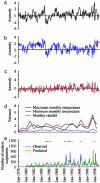Association between climate variability and malaria epidemics in the East African highlands
- PMID: 14983017
- PMCID: PMC356958
- DOI: 10.1073/pnas.0308714100
Association between climate variability and malaria epidemics in the East African highlands
Erratum in
- Proc Natl Acad Sci U S A. 2004 Sep 14;101(37):13694
Abstract
The causes of the recent reemergence of Plasmodium falciparum epidemic malaria in the East African highlands are controversial. Regional climate changes have been invoked as a major factor; however, assessing the impact of climate in malaria resurgence is difficult due to high spatial and temporal climate variability and the lack of long-term data series on malaria cases from different sites. Climate variability, defined as short-term fluctuations around the mean climate state, may be epidemiologically more relevant than mean temperature change, but its effects on malaria epidemics have not been rigorously examined. Here we used nonlinear mixed-regression model to investigate the association between autoregression (number of malaria outpatients during the previous time period), seasonality and climate variability, and the number of monthly malaria outpatients of the past 10-20 years in seven highland sites in East Africa. The model explained 65-81% of the variance in the number of monthly malaria outpatients. Nonlinear and synergistic effects of temperature and rainfall on the number of malaria outpatients were found in all seven sites. The net variance in the number of monthly malaria outpatients caused by autoregression and seasonality varied among sites and ranged from 18 to 63% (mean=38.6%), whereas 12-63% (mean=36.1%) of variance is attributed to climate variability. Our results suggest that there was a high spatial variation in the sensitivity of malaria outpatient number to climate fluctuations in the highlands, and that climate variability played an important role in initiating malaria epidemics in the East African highlands.
Figures

Similar articles
-
Climate variability and malaria epidemics in the highlands of East Africa.Trends Parasitol. 2005 Feb;21(2):54-6. doi: 10.1016/j.pt.2004.11.002. Trends Parasitol. 2005. PMID: 15664525 Review.
-
Climate variability and malaria epidemics in the highlands of East Africa.Trends Parasitol. 2005 Feb;21(2):52-3. doi: 10.1016/j.pt.2004.11.007. Trends Parasitol. 2005. PMID: 15664524 Free PMC article. Review.
-
Climate change and the resurgence of malaria in the East African highlands.Nature. 2002 Feb 21;415(6874):905-9. doi: 10.1038/415905a. Nature. 2002. PMID: 11859368 Free PMC article.
-
Seasonal associations of climatic drivers and malaria in the highlands of Ethiopia.Parasit Vectors. 2015 Jun 24;8:339. doi: 10.1186/s13071-015-0954-7. Parasit Vectors. 2015. PMID: 26104276 Free PMC article.
-
Development and validation of climate and ecosystem-based early malaria epidemic prediction models in East Africa.Malar J. 2014 Aug 22;13:329. doi: 10.1186/1475-2875-13-329. Malar J. 2014. PMID: 25149479 Free PMC article.
Cited by
-
Spatial spillovers of violent conflict amplify the impacts of climate variability on malaria risk in sub-Saharan Africa.Proc Natl Acad Sci U S A. 2024 Apr 9;121(15):e2309087121. doi: 10.1073/pnas.2309087121. Epub 2024 Apr 1. Proc Natl Acad Sci U S A. 2024. PMID: 38557184 Free PMC article.
-
Towards an intelligent malaria outbreak warning model based intelligent malaria outbreak warning in the northern part of Benin, West Africa.BMC Public Health. 2024 Feb 13;24(1):450. doi: 10.1186/s12889-024-17847-w. BMC Public Health. 2024. PMID: 38347490 Free PMC article.
-
Utilizing a novel high-resolution malaria dataset for climate-informed predictions with a deep learning transformer model.Sci Rep. 2023 Dec 28;13(1):23091. doi: 10.1038/s41598-023-50176-3. Sci Rep. 2023. PMID: 38155182 Free PMC article.
-
Investigating the Impact of Irrigation on Malaria Vector Larval Habitats and Transmission Using a Hydrology-Based Model.Geohealth. 2023 Dec 10;7(12):e2023GH000868. doi: 10.1029/2023GH000868. eCollection 2023 Dec. Geohealth. 2023. PMID: 38089068 Free PMC article.
-
Systematic review of sporozoite infection rate of Anopheles mosquitoes in Ethiopia, 2001-2021.Parasit Vectors. 2023 Nov 27;16(1):437. doi: 10.1186/s13071-023-06054-y. Parasit Vectors. 2023. PMID: 38008761 Free PMC article. Review.
References
Publication types
MeSH terms
Grants and funding
LinkOut - more resources
Full Text Sources
Medical
Miscellaneous

